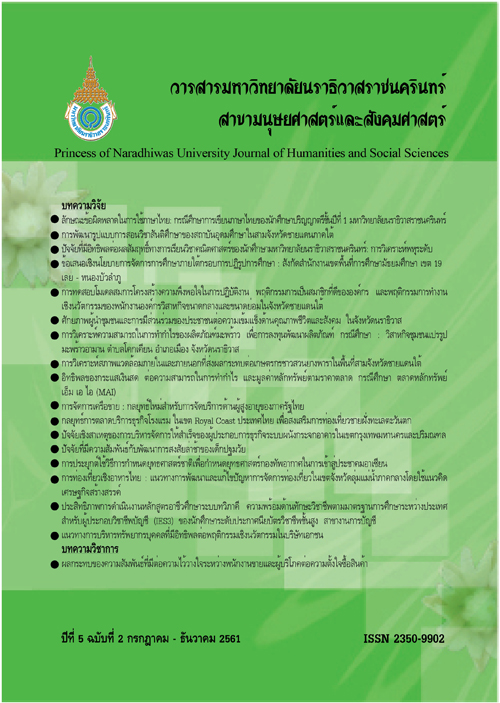The Effect of Trust-based Relationship between Salesperson and Customer on Intention to Purchase
Main Article Content
Abstract
This article aimed to provide better understanding of how consumers’ perceived trust in salesperson is a key to earn customers’ good intention toward purchasing products from the stores. Despite the desire of customer on a particular product, the positive perception of trust towards the salesperson is able to influence customer to patronage recommended goods by the salesperson in this study. The degrees of trust in salesperson was discussed in this article to illustrate varies of each degree can generate customers’ perceived trust on customers. The article then further clarified that relationship between salesperson and customer is fostered base on the foundation of trust and willingness to rely on another party. Besides, consumers’ perceived trust in salesperson help to eliminate the perception of being exploited.
Article Details
References
two-dimensional scale. Journal of Business & Industrial Marketing, 31(2), 260-273.
2.Bateman, C., & Valentine, S. (2015). The impact of salesperson customer orientation on the evaluation of a
salesperson's ethical treatment, trust in the salesperson, and intentions to purchase. Journal of
Personal Selling & Sales Management, 35(2), 125-142.
3.Chebat, J.-C., & Oumlil, A. B. (2015). Proceedings of the 1998 Multicultural Marketing Conference: Springer.
4.CSO Insights. (2016). Sales Performance Optimization Study, 1-25.
5.Ellis, K. L., & Beatty, S. E. (1995). Customer relationships with retail salespeople: a conceptual model and
propositions. NA-Advances in Consumer Research Volume 22.
6.Ganesan, S. (1994). Determinants of long-term orientation in buyer-seller relationships. The journal of
marketing, 1-19.
7.Geyskens, I., Steenkamp, J.-B. E., Scheer, L. K., & Kumar, N. (1996). The effects of trust and interdependence
on relationship commitment: A trans-Atlantic study. International Journal of research in marketing,
13(4), 303-317.
8.Guenzi, P., De Luca, L. M., Spiro, R., Johnston, W., & Johnston, W. (2016). The combined effect of customer
perceptions about a salesperson's adaptive selling and selling orientation on customer trust in the
salesperson: a contingency perspective. Journal of Business & Industrial Marketing, 31(4).
9.Guenzi, P., & Georges, L. (2010). Interpersonal trust in commercial relationships: Antecedents and conse
quences of customer trust in the salesperson. European Journal of Marketing, 44(1/2), 114-138.
10.Homburg, C., & Stock, R. M. (2005). Exploring the conditions under which salesperson work satisfaction
can lead to customer satisfaction. Psychology & Marketing, 22(5), 393-420.
11.Johnson, D., & Grayson, K. (2005). Cognitive and affective trust in service relationships. Journal of business
research, 58(4), 500-507.
12.Kennedy, M. S., Ferrell, L. K., & LeClair, D. T. (2001). Consumer's trust of salesperson and manufacturer: an
empirical study. Journal of business research, 51(1), 73-86.
13.Lewis, J. D., & Weigert, A. (1985). Trust as a social reality. Social forces, 63(4), 967-985.
14.Lin, L.-Y., & Chen, Y.-W. (2009). A study on the influence of purchase intentions on repurchase decisions:
the moderating effects of reference groups and perceived risks. Tourism Review, 64(3), 28-48.
15.Lin, L.-Y., & Lu, C.-Y. (2010). The influence of corporate image, relationship marketing, and trust on purchase
intention: the moderating effects of word-of-mouth. Tourism Review, 65(3), 16-34.
16.Madahi, A., & Sukati, I. (2012). The effect of external factors on purchase intention amongst young generation
in Malaysia. International Business Research, 5(8), 153.
17.Martin, N. (2008). Habit the 95% of behavior marketers ignore. New Delhi: Pearson.
18.McKnight, D. H., Choudhury, V., & Kacmar, C. (2002). The impact of initial consumer trust on intentions to
transact with a web site: a trust building model. The journal of strategic Information Systems,
11(3), 297-323.
19.Moorman, C., Zaltman, G., & Deshpande, R. (1992). Relationships between providers and users of market
research: The dynamics of trust within and between organizations. Journal of marketing research,
29(3), 314.
20.Morgan, R. M., & Hunt, S. D. (1994). The commitment-trust theory of relationship marketing. The journal
of marketing, 20-38.
21.Parsons, A. L. (2002). What determines buyer‐seller relationship quality? An investigation from the buyer's
perspective. Journal of Supply Chain Management, 38(1), 4-12.
22.Rempel, J. K., Holmes, J. G., & Zanna, M. P. (1985). Trust in close relationships. Journal of personality and
social psychology, 49(1), 95.
23.Rutherford, B. (2012). Building buyer commitment to the salesperson. Journal of business research, 65(7),
960-967.
24.Sirdeshmukh, D., Singh, J., & Sabol, B. (2002). Consumer trust, value, and loyalty in relational exchanges.
Journal of marketing, 66(1), 15-37.
25.Swan, J. E., Trawick, I. F., & Silva, D. W. (1985). How industrial salespeople gain customer trust. Industrial
Marketing Management, 14(3), 203-211.
26.Twing-Kwong, S., Gerald Albaum, L., & Fullgrabe, L. (2013). Trust in customer-salesperson relationship in
China's retail sector. International Journal of Retail & Distribution Management, 41(3), 226-248.
27.Weitz, B. A., & Bradford, K. D. (1999). Personal selling and sales management: A relationship marketing
perspective. Journal of the academy of marketing science, 27(2), 241-254.
28.Wong, A., & Sohal, A. (2002). An examination of the relationship between trust, commitment and relationship
quality. International Journal of Retail & Distribution Management, 30(1), 34-50.


